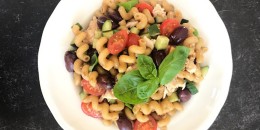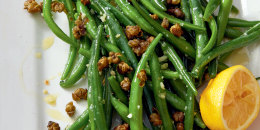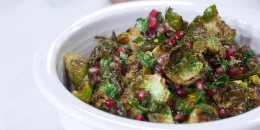Chef notes
Craving cruciferous vegetables, summer squash or juicy tomatoes? Sometimes there's nothing better than a nutritious and delicious plate of roasted vegetables.
When you're ready to roast, it's important to brush up on how best to prepare your vegetables of choice — because nobody wants undercooked beets, overcooked zucchini or soggy green beans.
The first thing to consider when roasting is understanding which type of vegetable you want to cook. Root vegetables, for example, typically have longer cook times and often require a smaller dice. Some vegetables, like beets, can be wrapped in foil whole and and roasted until a knife easily pierces the center. Vegetables with a higher water content, like squash or eggplant, need a hotter oven and a shorter cook time, otherwise you'll end up with a dry, shriveled-up side dish.
Best vegetables to roast
When it comes to which vegetables taste best when roasted in the oven, it can be hard to choose the wrong one! Carrots, broccoli, Brussels sprouts, cauliflower, any variety of squash, pumpkin, potatoes, onions, parsnips and beets are some great options.
The only veggies that don't roast well? If you're thinking about roasting delicate salad greens, like baby spinach or arugula, don't.
Most veggies roast up well simply seasoned with just some olive oil, salt and pepper. You can always spruce up your veggies with a little bacon fat, just like Al Roker.
The basics of oven-roasting
Always make sure the oven is fully preheated before roasting: About 375-400 F for root vegetables, and 400-425 F for veggies that have more water. If the oven is the wrong temperature, your cooking time might not yield the desired result.
Preheat your tray in the oven while you prepare your vegetables. This way, when they make contact with the tray, they instantly begin to sizzle and roast. You also may not want to use parchment paper when roasting my vegetables because it limits the browning you get on the surface of the vegetables (but, of course, if you don't want to clean the baking sheet, by all means, use it).
To make sure your vegetables are evenly coated with oil and seasoning, toss everything together in a bowl before laying them out on the tray. Don't overcrowd the veggies or the hot air won't circulate and the veggies will steam instead of roast.
About every 10 minutes or so, rotate the tray in the oven so all the vegetables are being evenly roasted. You should also stir them around a bit using a spatula to make sure they’re crisping evenly and not sticking to the tray. Some ovens have hot spots where one side cooks more than the others, which is why its always good to rotate your trays while roasting.
If you try to flip your veggies and they're sticking to the pan, it means they're not ready to flipped. Have patience and the veggies will respect you.
How to roast frozen vegetables
Follow the same basic tips as you would with raw veggies when roasting frozen ones. That being said, because they have more water in them, they will likely steam before browning and will therefore take a little more time to achieve that an ideal roasted golden-brown color.
How to roast vegetables without oil
Roasting vegetables without seasoning is possible, but not advised. Don't expect the veggies to get the same caramelization and browning as if you had used oil. If you really don't want to use any oil, consider roasting the veggies on parchment paper or aluminum foil for easier cleanup. Make sure to flip them as you would any other roasted veggies.
How to reheat roast vegetables
There are several ways to get leftover roasted vegetables back to their deliciously crisp state. Put them back in the oven, spread them out evenly on a baking tray and reheat them for about 10 minutes. You can also throw them in a skillet with a little oil, add them into a stir-fry recipe, or use an air fryer or a toaster oven until they're warmed through and slightly crisp. Whatever you do, don't reheat them in the microwave, as they can get soggy and mushy.
Your key takeaways
Be sure to season your vegetables generously with salt.
Don't overcrowd the vegetables or the hot air won't circulate and they'll steam instead of roast.
Rotate the trays and stir the vegetables around a bit with a spatula to make sure they're crisping evenly and not sticking to the tray, every 10 minutes or so.
Actual cooking times may vary based on the oven, quantity being roasted and your preference of doneness (how fork-tender they are).
Although not necessary, starting with a hot pan will expedite cooking time and help increase caramelization.
Ingredients
- vegetables (or fruit) of choice
- olive oil
- kosher salt and freshly ground black pepper, to taste
Preparation
How to roast vegetables:
1.Preheat the oven (375-400 F for root vegetables, and 400-425 F for veggies that have more water).
2.Cut vegetables to desired size, if necessary. In a large bowl, toss prepared vegetable (or fruit), olive oil, salt and pepper and any other desired seasonings or herbs, until evenly coated.
3.Spread out evenly onto baking tray, being sure not to overcrowd.
4.Roast according to cooking times listed below, rotating every 10 to 15 minutes. Toss vegetables with a spatula before placing tray back into the oven to ensure they are roasting evenly.
5.Roast until vegetables are browned and tender. The time will vary per type of vegetable, so keep your eye on them. A medley of vegetables like parsnips, onions, bell peppers and beets cut into about 1-inch pieces will take about 30 to 40 minutes.
Vegetable cooking times:
Asparagus (pencil), whole with ends trimmed: 15 to 20 minutes
Bell pepper, cut into 1/4-inch strips: 15 to 20 minutes
Broccoli, cut into florets: 20 to 25 minutes
Brussels sprouts, halved: 20 to 25 minutes
Carrots (small), whole: 20 to 25 minutes
Cauliflower, cut into florets: 15 to 20 minutes
Onion, cut into 1/4-inch slices: 15 to 20 minutes
Potato (fingerling), halved lengthwise: 25 to 30 minutes
Butternut squash, peeled and cut into 3/4-inch cubes: 20 to 25 minutes
Sweet potato, cut into 1/4-inch medallions: 15 to 20 minutes
Tomato (grape or cherry), whole: 15 to 20 minutes
Zucchini, cut into 1/4-inch medallions: 15 to 20 minutes













